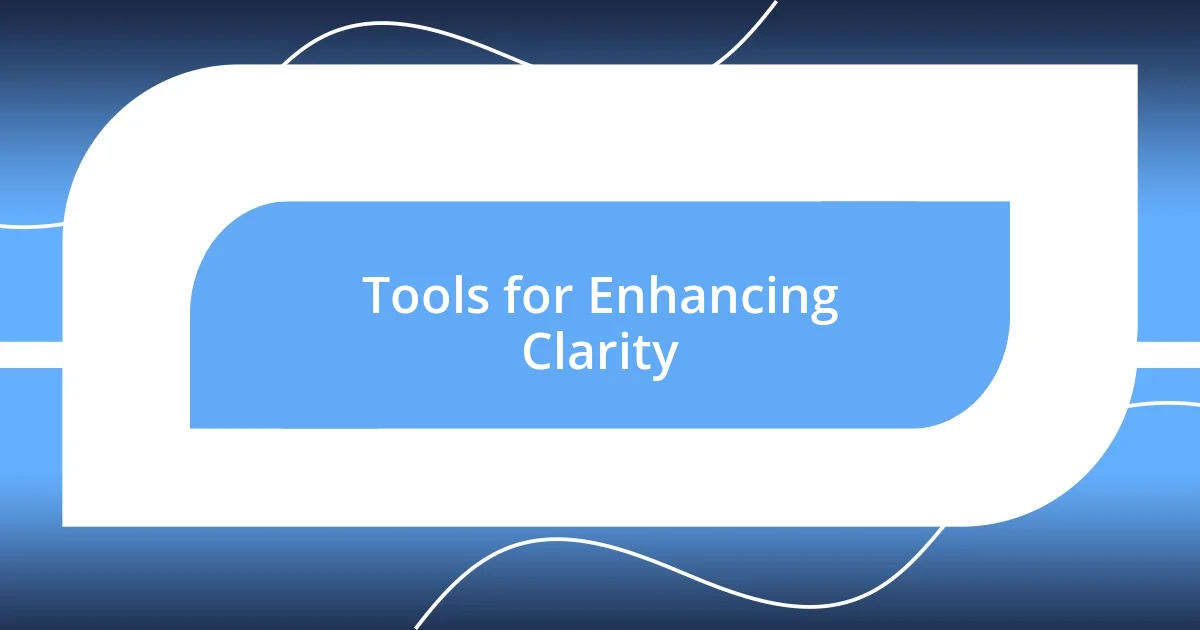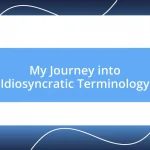Key takeaways:
- Linguistic confusion arises from multiple meanings of words, cultural nuances, and differing personal experiences, highlighting the need for empathy and understanding in communication.
- Common misunderstandings include the use of literal vs. figurative language, regional slang, and cultural references, which can lead to humorous or enlightening moments.
- Effective communication strategies involve active listening, simplifying language, and using visual aids to enhance clarity and connection, ultimately transforming confusion into comprehension.

Understanding Linguistic Confusion
Linguistic confusion often arises when words or phrases have multiple meanings or when cultural context shifts their significance. I remember a time when I enthusiastically used the term “sick” to describe something I loved, only to be met with puzzled expressions. This moment made me appreciate how the same word could evoke completely different feelings, depending on the listener’s background.
Have you ever felt uncertain about whether your words were coming across as intended? This happens to me frequently, especially in diverse environments where people might interpret expressions through their personal lenses. It’s fascinating how language evolves and how it reflects our shared experiences—or lack thereof—leading to those head-scratching moments of miscommunication.
Understanding linguistic confusion requires not just knowledge of vocabulary but an awareness of cultural nuances and emotional contexts. When I’ve approached conversations with curiosity rather than frustration, I’ve often discovered rich layers of meaning and connection. This process has taught me that clarity isn’t just about choosing the right words; it’s about being open to understanding and engaging with others’ perspectives, which can be a transformative experience.

Common Language Misunderstandings
Language misunderstandings are surprisingly common, often leading to moments that are both amusing and enlightening. I recall an instance during a business meeting when I used the term “pitch” to describe my proposal. To my astonishment, several team members thought I was talking about the tone of my voice rather than the idea itself. It was a stark reminder of how easily we can drift into different interpretations, all while intending to connect.
Here are some common language misunderstandings that many of us might encounter:
- Literal vs. Figurative Language: Using phrases like “kick the bucket” might confuse those who take it literally.
- Regional Slang: Terms like “pop” for soda can create bewilderment across different parts of the country.
- Cultural References: Jokes or phrases that resonate in one culture may leave others baffled.
- Technical Jargon: Words understood in one profession can feel alienating in another, creating barriers to communication.
- Politeness Levels: Expressions of disagreement can differ dramatically, leading to misinterpretation of intent.
Reflecting on these experiences and misunderstandings allows us to embrace the beauty of language while navigating its complexities. Each moment of confusion can spark laughter or lead to deeper understanding, reminding me that our conversations are always an opportunity for connection.

Practical Examples of Miscommunication
Linguistic misunderstandings often manifest in the most unexpected scenarios. For instance, during a casual dinner with friends, I mentioned needing to “wind down” and then was met with puzzled looks. To them, “wind down” suggested a physical task rather than the mental relaxation I intended. This instance highlighted how even the simplest phrases can spin off into different interpretations based on context and personal experiences.
I’ve also experienced moments when idiomatic expressions led to significant confusion. Recently, while chatting with a colleague who wasn’t a native English speaker, I used the idiom “breaking the ice” to suggest starting a conversation. My friend’s expression was a mix of curiosity and confusion, as they interpreted it literally. This taught me the importance of considering the listener’s background; what feels normal and understood to one might be a source of confusion for another.
Ultimately, these miscommunications can be amusing and humbling at the same time. They remind us that language is not just about the words we choose; it’s about the bridges we build through understanding and empathy. Each linguistic mix-up can serve as a valuable opportunity to deepen our connections and share laughter, transforming confusion into comprehension.
| Scenario | Miscommunication |
|---|---|
| Phrase Used | Meaning Interpreted |
| Winding down at dinner | Physical action or relaxation? |
| Breaking the ice | Literal ice breaking or starting a conversation? |

Strategies to Clarify Language
Clarifying language can be approached with a few strategies that hinge on empathy and active engagement. I find that paraphrasing what someone has just said can work wonders. For example, during a discussion, I often summarize their main points to ensure I’ve captured their intent correctly. Have you ever tried this? It not only clears up confusion but also shows the speaker that you value their input.
Another effective strategy is asking open-ended questions. When I sense someone is puzzled, I gently prompt them to elaborate on their thoughts or feelings. For instance, instead of saying, “Do you understand?” I might ask, “What are your thoughts on this?” This way, it encourages a richer dialogue and often illuminates areas where we need to clarify our meanings.
Lastly, using simple, straightforward language whenever possible is key. I recall a time when I was explaining a complex concept to a friend. Rather than bombarding them with jargon, I broke it down into bite-sized bits—think of it like making a complicated recipe easy to follow. This approach not only fosters clarity but builds a more inclusive conversation, inviting everyone to participate without the fear of misunderstanding.

Techniques for Effective Communication
Effective communication thrives on techniques that promote clarity and understanding. One method I rely on frequently is mirroring the emotions of the person I’m speaking with. For example, during a recent team meeting, a colleague expressed frustration over a project delay. I made a point to acknowledge their feelings by saying, “I can see how this would be upsetting.” This small but impactful technique not only validated their emotions but also created a more open atmosphere for discussion.
Another practice that I find immensely useful is the art of active listening. I remember a conversation with a friend who was going through a tough time. Instead of planning my response while they spoke, I focused entirely on their words. I nodded, maintained eye contact, and asked follow-up questions. This deepened our connection and assured them that their experiences mattered. Have you ever noticed how people open up when they feel truly heard? It’s astonishing how a little attentiveness can dismantle barriers.
Finally, I’d argue that using visuals or examples can bridge gaps in understanding. I often draw diagrams or use relatable metaphors during explanations. In one instance, while trying to explain a technical concept to a relative, I compared it to things they were familiar with, like cooking. This connection not only clarified my message but also made the conversation enjoyable. Isn’t it fascinating how linking ideas to everyday experiences can transform complex topics into something accessible?

Tools for Enhancing Clarity
Utilizing technology can significantly enhance clarity in communication. For instance, I often rely on tools like Grammarly for writing. When I first started using it, I was amazed at how much it helped me catch confusing phrasing and suggest clearer alternatives. Have you ever had a text where the meaning seemed lost in translation? This tool not only sharpens my writing but also boosts my confidence in conveying ideas effectively.
Additionally, visual aids can be a game-changer. I remember tackling a complicated project at work where my team struggled to grasp the concepts. I decided to create infographics that illustrated the information visually. The moment I presented those visuals, I saw the lightbulb moments around the room. It’s incredible how a simple image can replace a thousand words. Have you experienced that instant clarity when you see a complex idea laid out visually?
Lastly, leveraging collaborative platforms can foster a more engaging conversation. Tools like Miro allow teams to brainstorm together in real-time. I recently facilitated a virtual meeting using Miro, which allowed everyone to contribute their thoughts visually. It transformed our discussions from mere words to visual representations, promoting deeper understanding among participants. How do you think collaborative platforms can change the way we communicate? I believe they open up a new layer of connection that traditional methods often miss.

Conclusion on Linguistic Clarity
Achieving linguistic clarity is essential for effective communication, and I can’t stress enough how it shapes interactions. Recently, I found myself in a conversation that was becoming muddled due to jargon-heavy terms. I paused, simplified my language, and noticed an immediate shift in my friend’s expression—from confusion to understanding. Isn’t it amazing how clarity can transform the dynamics of a conversation?
Reflecting on my experiences, I’ve learned that clarity often hinges on our willingness to adapt our message to our audience. During a family gathering, I spoke about a complex topic but realized my relatives didn’t share the same background knowledge. So, I reframed my explanation using everyday language and relatable examples, and it was like unlocking a door for them. Have you ever felt the satisfaction of seeing eyes light up when they finally grasp a concept?
Ultimately, each interaction offers us the chance to refine our communication skills. I often remind myself that it’s not just about what I say, but how I say it. Just last week, while leading a workshop, I made a conscious effort to check in with participants frequently. Their feedback during the session indicated that they felt involved and valued. Isn’t that what we’re all aiming for—to encourage a dialogue that fosters genuine understanding?












